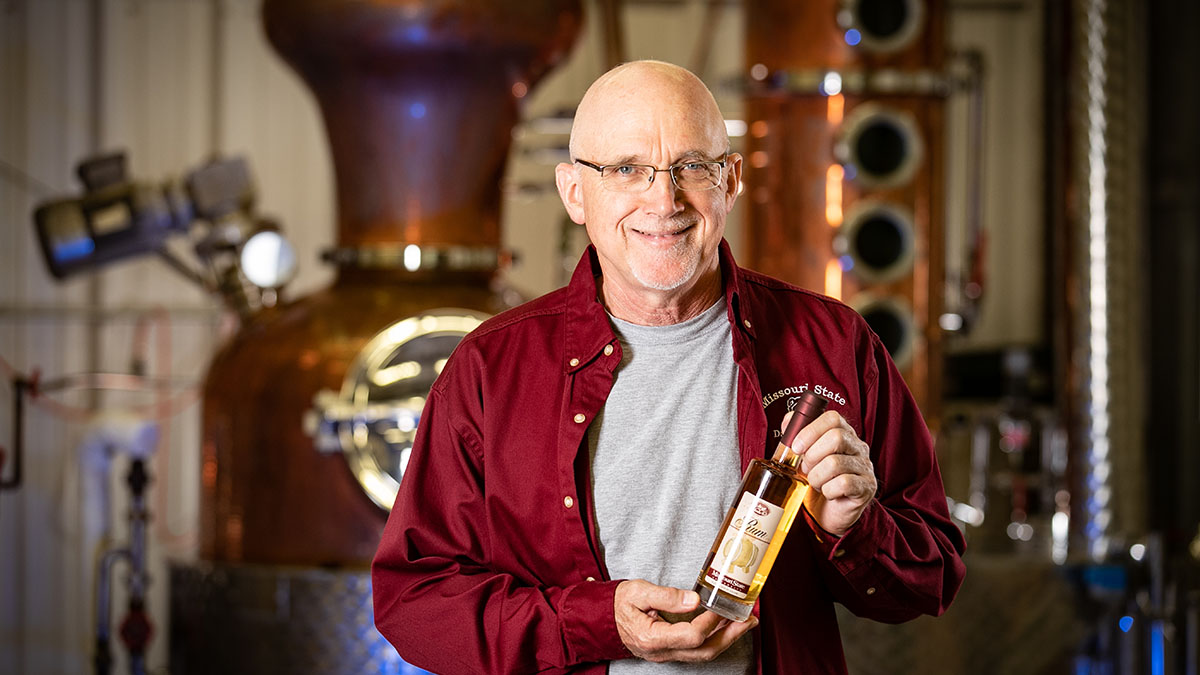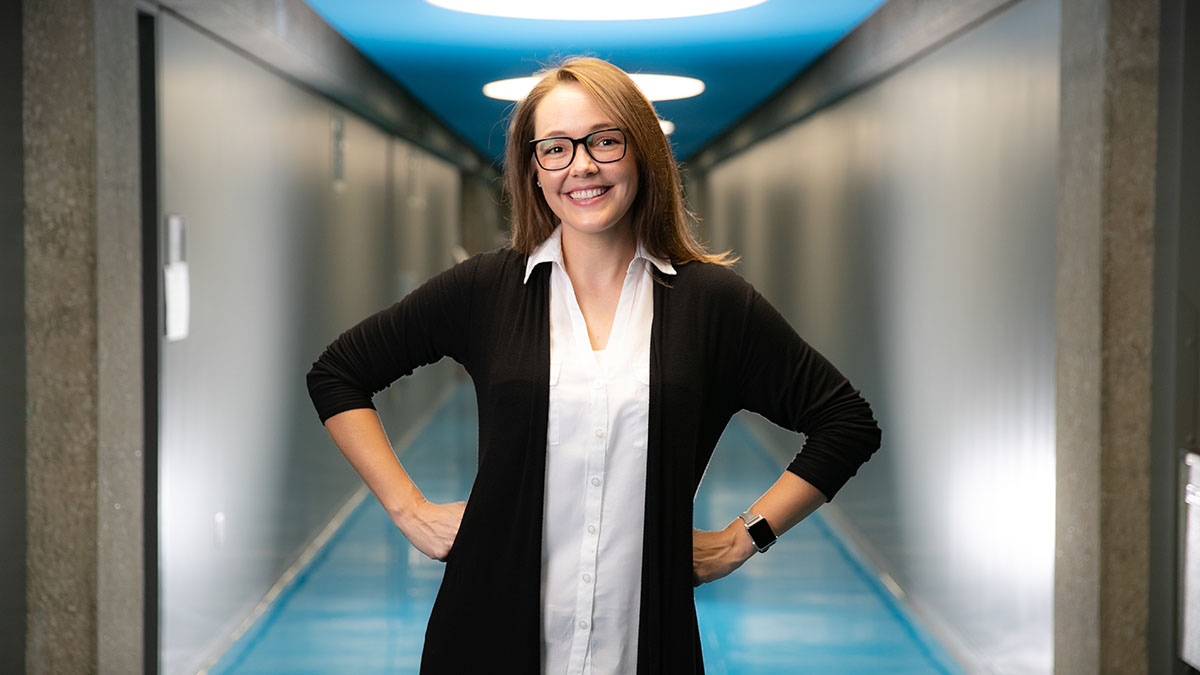Archive for November, 2020

Making a name in wines and spirits
One man whose dedication and expertise have advanced the facility’s operations is Dr. Karl Wilker. He serves as manager, winemaker and distiller. He’s also a research professor in the Darr College of Agriculture. The college houses the winery and distillery, which is part of the Missouri State Fruit Experiment Station.
Creating commercial wines
During his horticulture PhD program in the 1980s, Wilker immersed himself in winemaking. It grew into a passion.
For more than a decade now, this passion has driven him to develop the best wines possible at MSU. He uses grapes grown at the Fruit Experiment Station.
“Before I took over the winemaking, we were making port only. So, I started taking all the varieties of grapes we grew and making different types of wine,” Wilker said.
Among the wines currently produced and sold include Chambourcin (a French-American hybrid), Cynthiana (dry red), Norton (Missouri’s state grape), Pink Catawba (sweet blush) and White Blend (crisp white).
“I like the challenge of doing things to a high-quality level, and continuously learning and advancing.”

Tasting and comparing batches: Dr. Karl Wilker and Jeremy Emery work to perfect these spirits in the distillery.
To make high-quality wines, Wilker applies the science of chemistry, fermentation, food processing and microbiology. But ultimately, it comes down to smell and taste. Wilker relies on his experience of tasting many types of wines, and his sensory skills, honed through the years.
“You have to try a lot of different products and emulate the best ones,” Wilker said. “The process is very sensory-guided. You have to get a feel for what quality is.”
Experimenting with rum
Besides winemaking, Wilker also focuses on distilling. In recent years, he has made rum in the distillery. He mixes molasses with water and leaves the mixture to ferment and distill. The resulting rum rests in oak barrels and ages for about two years.
How does Wilker know when the rum is ready?
“I taste and keep tasting. I have an idea of the average time it should take, but each barrel has a different fermentation and composition,” he explained. “The quality of the final product is the result of many decisions and actions during its production.”
Dr. Wenping Qiu is Wilker’s colleague in the college who researches grape genetics. He believes Wilker has taken the university’s winery and distillery to the next level.
“Dr. Wilker doesn’t hesitate to try new methods in producing new styles of wine or spirits,” Qiu said. “He adjusts every detail in winemaking to make high-quality wines and has revived the distillation operation for commercial production.”
This slideshow requires JavaScript.
Racking up awards
In 2007, Wilker led efforts to enter Missouri State’s wines and spirits into competitions.
“I saw it as a way for us to show what was going on here and evaluate what we’re doing,” Wilker said.
Since then, he and his team have won 60-plus awards from competitions across the country. These include the Jefferson Invitational Wine Competition, Mid-American Wine Competition and New York World Wine & Spirits Competition.
“If you don’t have a feel for what quality is, it’s really hard to get anywhere because that guides everything we do here.”
Two of the top awards won are the Jefferson Cup Trophy (2019 and 2016) and Sweepstakes winner (2016 and 2014). Rum took home the first award for 2020 – a silver at the San Francisco World Spirits Competition.

Dr. Karl Wilker walks through the vineyard at the Mountain Grove campus.
Sharing his expertise
In his role, Wilker imparts his knowledge and skills to community members. Over the years, he has led or co-presented more than 30 workshops. They range from home winemaking to wine tasting and distillation.
Wilker also supports grapes genetics research – like Qiu’s. He takes the new varieties of grapes and turns them into commercial bottled wines.
“It’s a good test for the grapes to see if they survive the winemaking process,” Wilker said. “Dr. Qiu’s team can then evaluate the quality of the wine and show it to people in the industry.”
He added that so far, he has worked with two new varieties, a white grape since 2016 and a red one from 2019. The former looks promising.
“If we don’t have someone like Dr. Wilker who makes wines out of new grapes, we can’t release new grape varieties,” Qiu said.
- Story by Emily Yeap
- Photos by Kevin White
Further reading

Aim for competent communication in collaboration
Dr. Carrisa Hoelscher, director of graduate communication studies at Missouri State University, sets her target on competent communication to help others improve their skills. This includes finding ways to improve both effectiveness and appropriateness.
Being effective and appropriate can feel like they are at odds sometimes. This creates tension — Hoelscher’s research area. She examines tensions in collaborative communication, like in committees within the nonprofit or governmental sector.
“Do we err on the side of appropriateness, or do we err on the side of effectiveness when communicating? That’s kind of the undercurrent of everything,” Hoelscher said. “When I’m studying small-group interaction, what I’m most interested in is the underlying tension people tend to feel but don’t have words for and what they can do to address those tensions.”
Hoelscher carved out a niche at the intersection of collaboration and tension to provide suggestions to improve communication in groups. So far, she’s co–authored a textbook, published many articles and contributed to several books. She’s always looking to produce practical lessons for application in real-life scenarios.

Collaboration comes with unique tensions. Dr. Carrisa Hoelscher studies these in hopes of improving the experience.
Working together
When grave community issues creep up, task forces with agency representatives often come together. Each offers a different perspective, set of resources and ability to address the needs.
“These agencies are trying to make the world a better place,” Hoelscher said. “We’re seeing agencies having to collaborate more — to do more with less.”
For one study, she followed an interagency group as it developed and implemented a strategic plan to address substance-abuse issues. She observed the meetings for more than three years, detecting and tracking tensions in the talk among collaborators. She also interviewed participants and collected documents to help categorize types of tensions and document the shifting meaning of these tensions for group members over time.
“We have the luxury of going for effectiveness in our own organizations. Meanwhile, almost always, in a collaboration, you have to err on the side of appropriateness, because the relationship is flat and fragile.”
As a result, she published a new article in 2019 on tensions in collaboration and is currently working on a follow-up project. This line of research outlines seven dialectical tensions collaborators may experience. It also provides a framework of best practices for managing those tensions.
“These are tensions, like autonomy and connectedness,” Hoelscher explained. “You want both. You can have both. But they feel like opposites.”
Other examples include skepticism and optimism, collaborative and competitive, creativity and parameters, necessary and palatable change, and impactful and viable change.
Hoelscher’s work helps practitioners identify the tensions in their own experiences. The work also provides practical suggestions like acknowledging the tension, delaying tension management and hedging for more appropriateness.
“The traditional tension everybody uses as an example is a romantic relationship. Almost everybody feels the tension between wanting to feel connected, but wanting to maintain autonomy and independence. We want both of those things at the same time, but they feel like opposites.”
These tactics can help people to successfully manage the uncomfortable moments and use the tension to lead to better outcomes.

Getting a seat at the table is very important. Equally important? Keeping communication open between all parties. If not, says Dr. Carrisa Hoelscher, the collaboration will fizzle.
“In collaboration, we have to care more about the end product than our own organization because we are giving up something to get there and these tensions aren’t going away,” she said.
Many times, she added, the thing being given up is time to complete other tasks.
“’Are we getting enough bang for our buck?’ so to speak. That’s a common tension in these situations,” she said. “You have to be able to answer that question for everyone at the table and give them the tools to address those commitment-based tensions.”
Tensions lead to teachable moments
Hoelscher began researching this interagency collaboration for her dissertation under Dr. Michael Kramer. He is chair of the communication department at the University of Oklahoma.
“Carrisa’s work is changing the field,” he said. “She examines the way people actually talk and work together instead of focusing on the financial and other benefits that most researchers examine.”
Hoelscher notes that collaborative tensions must be managed differently or else the partnership will fizzle.
“When it comes to the types of tensions I talk about, discomfort may be telling you to pay more attention to a part that you’ve put in the back of your mind,” she said. “I hope my research contributes to making us more comfortable with discomfort.”
- Story by Nicki Donnelson
- Photos by Kevin White

